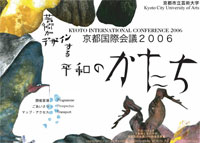
go to Kyoto International conference web site
Kyoto City University of Arts
Production:
Miki Shunji, researcher from the Research Centre for Japanese Traditional Music
From the Taisho period (1912-1926) until the beginning of Showa (1926-1989), Tanabe Hisao, one of the pioneering researchers in the field of Japanese and East Asian musicology, collected various instruments on his travels through an Asia that tottered on the brink of war. This exhibition and workshop offer an opportunity to reflect on him as an individual and the significance of his achievements. The workshop will provide an intimate setting for a public demonstration of many unique musical instruments.
Workshop : October 7th, 11-12 am
Exhibition : October 4-9, 10:30-2:00 pm
Venue : Research Centre for Japanese Traditional Music (Research building)7th floormap
This paper reviews some ways in which ethnomusicologists have sought to understand the nature and results of cultural contacts among people through the study of music. It suggests possibilities for an understanding of various musical cultures and what this offers to scholars and teachers for advocating peace. The peace referred to in this paper is relational—a desire for or an achieved condition between individuals, communities, or nations.
Speaker Introduction:
Professor Bonnie Wade currently resides in the United States. After graduating from Boston University, she entered graduate school at the University of California at Los Angeles (UCLA) where she majored in ethnomusicology. Her research centered on Japanese koto music, and in 1968 she received her master’s degree. Later she spent time in northern India researching Hindustani classical vocal music, which became the topic of her doctoral dissertation, earning her the Ph.D. degree in 1971. After spending several years as assistant professor at Brown University, she moved to the University of California at Berkeley, where she is currently professor in the department of music as well as departmental chair. Formerly she was also president of the Society for Ethnomusicology. Presently she is general editor for the Global Music Series published by Oxford University Press.
Date & Time : October 7th, 2-3:30pm
Venue : Kyoto City University of Art Auditorium map
Performer : Obakusan Manpukuji
Commentary : Akamatsu Tatsumyo (Manpukuji) Sawada Atsuko (Professor, Senzoku Gakuen College of Music)
Shomyo is the general term for a type of vocal that monks chant at Buddhist ceremonies and services. It may be said to be one of Buddhism’s intangible cultural treasures. It began in Japan with the transmission of Buddhism in the sixth century. Each Buddhist school, sect, and monastery developed their own technique, instruments, and musical notation. Obakusan Manpukuji was founded in Uji by Ingen Ryuki, a renowned Chinese monk who came to Japan in 1654. The shomyo at Manpukuji, termed Bonbai, developed during the long period of peace that prevailed during the Tokugawa period, and was carefully transmitted by successive generations of Chinese monks. Today’s performance is a valuable opportunity to recreate within the grounds of the university the essence of these Buddhist services. It is hoped that the Ming period pronunciation, termed, toin, or Chinese accentuation, accompanied by the beat of numerous percussion instruments will help you to savor the unique sound of Manpukuji.
Date & Time : October 7th, 3:40-5:00pm
Venue : Kyoto City University of Art Auditorium map